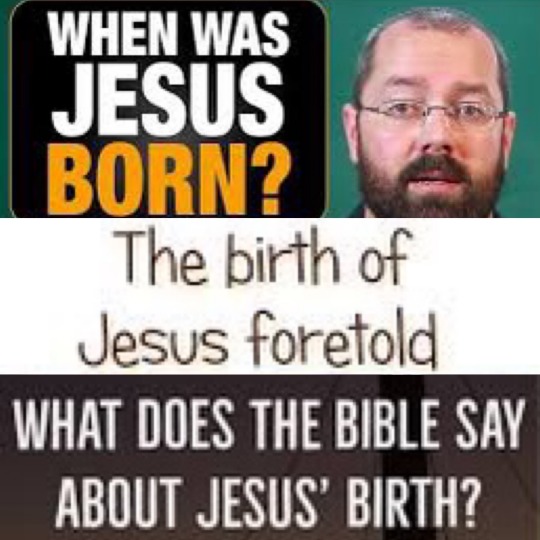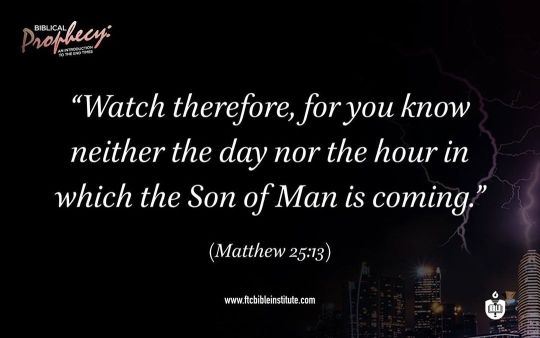#thetimeoftheend
Text

The Exact Month and Year of Jesus’ Birth Are Revealed in the Bible
By Bible Researcher & Goodreads Author Eli Kittim 🎓
Matthew 1.17 tells us the year of Jesus’ birth
Astoundingly, the gospel of Matthew imparts a cryptic clue concerning the birth of Jesus that hardly anyone knows about. Specifically, the ancestry of Jesus, as recorded in the gospel of Matthew, is actually a mathematical riddle whose solution reveals the precise year of his birth! The key to solving this puzzle can be found in Chapter 1 and Verse 17. Notice that there is a constant repetition of 14 generations throughout the foregoing lineage. We also know from Scripture that a generation is equal to 70 years (Ps. 90.10). Matthew 1.17 reads as follows:
there were fourteen generations in all from
Abraham to David, fourteen from David to
the exile to Babylon, and fourteen from the
exile to the Messiah.
One final clue: the calculation does not begin from the time of Abraham but from the time of David who alone represents the Messiah! Do the math.
So, let’s work out the calculation. Matthew tells us that there were 14 generations from David to Babylon. Each generation is equal to 70 years. Thus, 14 x 70 = 980 years from David to Babylon. And there were 14 generations from the exile to the Messiah. Therefore, 14 x 70 = 980 years. So, from David to the exile are 980 years, and from the exile to the Messiah are another 980 years. Hence 980 (+) 980 = 1960, the year of the Messiah’s birth! Mind you, this is not a historical but rather an esoteric rendering, which contains a cryptic clue concerning the year of Jesus’ birth!
Luke 1.26 tells us the month of Jesus’ birth
The Bible is very clear and very simple when it comes to imparting cryptic and esoteric clues. We don’t need to use overly technical, heavy-handed, and convoluted mathematical equations. For instance, in an attempt to figure out the month of Jesus’ birth, some scholars begin by applying the months pertaining to the 24 courses of the Levitical priests that rotate to minister in the Tabernacle (based on John the Baptist’s father in Luke 1.5, “Zechariah, of the division of Abijah”), and then, after figuring out the date of Elizabeth’s conception, they add 6 months to determine the timing of Mary’s conception (Luke 1.26, 36), and so on and so forth. But this calculation is far too complex and very confusing. By contrast, Luke’s gospel makes it very, very simple and very clear. Luke 1.26-27 reads thusly:
Now in the sixth month the angel Gabriel
was sent from God to a city in Galilee
named Nazareth, to a virgin betrothed to a
man whose name was Joseph, of the
descendants of David; and the virgin’s
name was Mary.
In Luke 1.26, the angel was sent “in the sixth month.” That’s the clue. That’s the key! Simple and to the point. The sixth month (in the Jewish religious calendar) is called Elul. In the Gregorian calendar it falls on the month of August. Thus, that’s the month that the Messiah is born!
Conclusion
In chapter 1 verse 17, Matthews’ genealogy is theological, not historical. That’s because “historically” it doesn’t make any sense. For example, we know that the Babylonian exile took place sometime around 586 BCE. If David lived approximately 980 years earlier, that would put David’s timeline at around 1566 BCE, which is historically inaccurate. David lived around 1,000 BCE. Similarly, 980 years after the Babylonian exile would put Jesus’ birth at around 394 CE (the fourth century), making him a contemporary of Jerome. So Matthew’s genealogy is obviously crypto-theological, not historical. It is meant to impart a mathematical riddle whose solution reveals the precise year of the Messiah’s birth!
But you may object and say, wait a minute. I thought Jesus was born in 4 BCE and died sometime around 30 CE, right? Well, not exactly. The gospels are theological, not historical, documents. Scholars know that the early extra-biblical references to Jesus by people like Josephus and Tacitus were tampered with (interpolations). What is more, there are no eyewitnesses and no first-hand accounts of Jesus. There are also many literary discrepancies in the New Testament. For example, the earliest New Testament writings (the Pauline letters) don’t contain the embellishments and legends we find in the later writings (the gospels). Not to mention the historical discrepancies as to whether Jesus was supposedly born in 4 BCE (Matthew) or 6 CE (Luke).
But, more importantly, the New Testament epistles themselves tell us that Jesus will actually be born during the consummation of the ages, or “in the fullness of time” (Gal. 4.4; Eph. 1.9-10), and that he will be “revealed [for the very first time] at the final point of time” (1 Pet. 1.20 NJB). Moreover, Hebrews 1.2 tells us that Jesus will speak to humankind in the “last days,” while Rev. 12.5 confirms that Jesus will be born in the end-times as a contemporary of the last empire on earth (the so-called “7-headed dragon with 10 horns”), during a time period just prior to *the great tribulation* that lasts 3 and a half years (see Rev. 12.5-6, 13-14). Similarly, Isaiah 2.19 says that the Lord rises (or resurrects) “to terrify the earth.” In other words, there’s no 2,000 year gap between Jesus’ resurrection and judgment day! Rather, they’re contemporaneous events. And Daniel 12.1-2 prophesies (in the Greek Septuagint) about a princely figure who will die and resurrect in the last days, just prior to the *general resurrection* of the dead.
So, there are many, many references to the Messiah’s one-and-only visitation in the end-times (e.g. Job 19.25; Zeph. 1.8—9, 15—18; Zech. 12.9—10; Lk. 17.30; Acts 2.17—21; 1 Cor. 1.7; Phil. 1.6; Col. 3.4; 1 Thess. 1.10; 2 Thess. 1.7; 2.1—3; 1 Tim. 6.14; 2 Tim. 4.1; Titus 2.13; 1 Pet. 1.13; 5.1; 1 Jn. 2.28; Rev. 19.10d)! But probably the most important and explicit reference to Jesus’ *atonement* and *death* at the end of days comes from Hebrews 9.26b (KJV), which says categorically and unequivocally that the timeline of this event is in the end-times:
once in the end of the world hath he [Jesus]
appeared to put away sin by the sacrifice
[or death] of himself.
So, according to Hebrews 9.26b, Jesus’ death takes place “in the end of the world,” not 2,000 years ago! Therefore, the one-and-only visitation of Jesus in the end-times is well-supported and multiply attested!
——-
For further scholarly details (from the original Greek) on the future incarnation of Christ, watch the following (short) video: ⬇️
A Biblical Greek Translation of Hebrews 9:26 that Changes Everything We Thought We Knew About Jesus
youtube
——-
I just spent some time giving you the backstory concerning the Jesus prophecy. Now that you understand the biblical timeline and context of Jesus’ one-and-only coming, let’s get back to what we were talking about earlier. So, in conclusion, Matthew 1.17 reveals the year of the Messiah’s birth (1960)! Similarly, Luke 1.26 reveals the month that the Messiah is born (in August)! Thus, Jesus the Messiah has already been born and will soon appear on the world stage. That’s precisely why the countdown to Armageddon began after the restoration of Israel in 1948. The rebirth of Israel in 1948 (Ezek. 38.8) marks a turning point in apocalyptic expectations in that modern Israel becomes the preeminent sign as regards the end of days (cf. Mt. 24.32-34; Acts 1.6). So the idea that the Messiah would be born 12 years after the rebirth of modern Israel coincides with the 70 weeks prophecy of Daniel. Accordingly, the so-called *restoration* of “Jerusalem, until Messiah the Prince” (Dan. 9.25), in the 70 weeks of Daniel, also began during this same time period! In other words, the 70 weeks prophecy of Daniel also prophesies of a coming messiah after the restoration of Israel. If you do the work of modern critical scholarship, it all fits like a glove. So, are we living in the last days? You better believe it!
——-
For further details on the 70 weeks of Daniel, see the following article: ⬇️
The Seventy Weeks of Daniel 9: A Critique of Questionable Interpretations
——-
#thejesusprophecy#bible prophecy#matthew1v17#the end of days#jesusbirthday#psalm90v10#the little book of revelation#εκ#biblestudies#biblicaleschatology#signs of the times#το_μικρό_βιβλίο_της_αποκάλυψης#revelation12v5#symbology#Luke1v26#EliKittim#lastdays#biblicalinterpretation#end times#theendoftheage#therevelationofjesus#thetimeoftheend#thefutureincarnationofchrist#ελικιτίμ#the end of the world#ek#Jesusbirth#Biblicalgenealogies#messianicbirth#Bible exegesis
0 notes
Photo

http://ftcbibleinstitute.com #prophecy #eschatology #todayisthedayofsalvation #Gospel #GoodNews #besaved #endtime #thetimeoftheend #Apocalypse #hearHisVoice #BibleInstitute #BibleCollege https://www.instagram.com/p/B-IkjACgr5X/?igshid=1109oy3rvdzzu
#prophecy#eschatology#todayisthedayofsalvation#gospel#goodnews#besaved#endtime#thetimeoftheend#apocalypse#hearhisvoice#bibleinstitute#biblecollege
0 notes